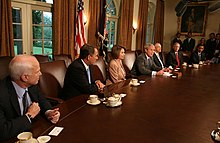Emergency Economic Stabilization Act
The US Emergency Economic Stabilization Act ( EESA ), about emergency law for economic stabilization , also known as the Paulson plan after US Treasury Secretary Henry Paulson is known, one on 19 September 2008 imagined bailout the Bush administration in support of the US financial market during the financial crisis from 2007 and includes measures worth about 700 billion US dollars, in the " Troubled Asset relief program " (about utility for troubled assets) can be specified. The EESA is seen as a prime example of “ lemon socialism ”.
Elements of the Paulson Plan
The law, which came into effect on October 3, 2008, provides that the US Treasury is permitted to purchase so-called "toxic assets" provided the seller is a financial institution and meets certain requirements. When the law goes into effect, the US Treasury will have $ 250 billion available to purchase toxic assets ; however, it should take several weeks, if not months, until binding purchase and valuation rules have been defined and the first transactions are carried out on the basis of the law. An additional $ 100 billion may be made available for purchases upon request by the White House. Another US $ 350 billion can now be used, as the House of Representatives approved this in a new vote.
A new authority, the Office of Financial Stability, was created to implement the aims of the law. Initially, 24 civil servants are to be employed here to coordinate the work of external financial service providers. It is Paulson's wish that external expertise is used to the greatest possible extent to carry out the acquisitions.
The plan also includes guarantees for savings accounts . In addition, tax cuts for the middle class and reductions in energy costs for companies were also decided. The aid package provides for parliamentary supervision and limits the severance payments for managers of the banks concerned. It is also planned that the state will share in possible future profits after a bank has been bailed out.
Meaning and criticism
The Paulson Plan is intended to secure the liquidity of the banking sector and serve to stabilize the US financial market, which is severely impaired in its function as a result of the financial crisis that began in 2007, particularly in the case of short-term money market transactions.
The majority of economists and politicians see the rescue plan as necessary. Opponents of the plan criticize its strong intervention in the market and that it prevents the bank sector, which is becoming increasingly opaque due to mutual participation, from being cleaned up, but above all that it burdens taxpayers with the risk of the loans that have to be taken over by the banks and are highly jeopardized. Previously private risks would become risks for the state and thus those of the taxpayer.
history
The plan was approved in several summit talks between politicians from both major parties and various business representatives at the end of September, but did not receive the required majority in the House of Representatives on September 29 . The revised version of the rescue plan was finally approved by the Senate on October 1, 2008 with 74:25 votes. On October 3, 2008, 263 members of the House of Representatives also approved the modified package; 171 elected officials rejected it. A majority of 218 was required. On October 6, Neel Kashkari was appointed interim administrator of the rescue fund.
Help for banks
With the money from the rescue package, the US government is buying stakes in banks and not buying mortgage loans as the financial market expects. “In the situation we were in, the value of bad loans was very difficult to determine. That was impractical and in principle impossible to achieve. That's why we changed course. ”( Henry Paulson , former US Treasury Secretary : Tagesschau.de: US government changes bailout package - more credit for more consumption ). In November 2008, the US government invested US $ 250 billion in economic stabilization in US banks.
Help for homeowners
As US Treasury Secretary Timothy F. Geithner said on February 10, 2009, the EESA or TARP program is intended to reduce the burden of mortgage payments with 50 billion US dollars. This is to help indebted homeowners who are threatened with a foreclosure sale of their houses.
A home loan is different in the US: the house is liable, not the person. If the auction doesn't "get" the money, the problem is with the bank, not the homeowner.
Help for credit card companies
Due to the poor financial situation, American Express has applied for funds in support of the Emergency Economic Stabilization Act amounting to three and a half billion US dollars. This was made possible by changes in the economic stabilization plan by former US Treasury Secretary Henry Paulson, who wanted to support credit card companies so as not to endanger consumption in the US.
Web links
- Linklaters dossier that describes the details of the "Emergency Economic Stabilization Act of 2008" (PDF file; 88 kB)
Individual evidence
- ↑ Spiegel-Online October 3, 2008: Bush signs US rescue package for the financial sector
- ^ Spiegel-Online October 3, 2008: 700 billion aid decided. Help is coming, prices are falling
- ^ Spiegel-Online October 4, 2008: US aid package. This will not end the crisis
- ↑ Tagesschau.de, Rüdiger Paulert: USA: billion grave real estate crisis of November 13, 2008 ( Memento of February 4, 2009 in the Internet Archive )
- ↑ Billions against doom - Tarp, Talf, Bad Bank - the confusion over the many aid packages of the US government in the fight against the crisis of the century is great. The FTD explains. by Tim Bartz (Frankfurt) ( Memento from February 14, 2009 in the Internet Archive )
- ↑ US government changes bailout package - more credit for more consumption ( Memento from February 4, 2009 in the Internet Archive )
